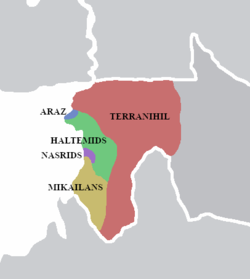Haltemid Caliphate
Haltemid Caliphate الخلافة الحالتمية Calafa Haltamast Ⲥⲁⲗⲁⲫⲁ Ⲏⲁⲗⲧⲁⲙⲁⲋⲧ | |||||||||||||||
|---|---|---|---|---|---|---|---|---|---|---|---|---|---|---|---|
|
Flag | |||||||||||||||
 Map of Vaktria in the 13th century | |||||||||||||||
| Status | Caliphate | ||||||||||||||
| Capital | Minaltar | ||||||||||||||
| Common languages | Arabic Vaktrian | ||||||||||||||
| Religion | Islam | ||||||||||||||
| History | |||||||||||||||
• Haltemids secede from Zuhraid Caliphate | 876 | ||||||||||||||
• Conquered by the Terranilian Empire | 1253 | ||||||||||||||
| |||||||||||||||
The Haltemid Caliphate (Arabic: الخلافة الحالتمية, Vaktrian: Ⲥⲁⲗⲁⲫⲁ Ⲏⲁⲗⲧⲁⲙⲁⲋⲧ, Calafa Haltamast) was an Imrani caliphate in the region of Vaktria during the middle ages. Imranis view the Haltemid Caliphs as Imams or religious leaders descendant from Muhammad.
The Emirate of Minaltar was incorporate as part of the Zuhraid Caliphate after the Zuhraid conquest of Vaktria in 760. Haltem, after whom the Haltemid dynasty is named, was a prominent general in Vaktria and became Emir of Minaltar in 825. The Haltemids were Imranis, a branch of Shiya Islam. In 870, they joined the Second Shiya Revolution against the Zuhraids and in support of Yazan ibn Ahmed, but later fought to form an independent caliphate.
After the collapse of the Zuhraid Caliphate in 876, the Haltemid Caliphate had a period of peace until the rebellion and secession of the Vaktrian Christian Mikailan Kingdom in 973. The Caliphate defended against crusades from the Mikailans. The Terranilian Empire took much of the northern lands of the Caliphate in 991. The Druz Emirate of Araz won independence from the Haltemids in 1200, and the Haythamite Nasrid Emirate seceded in 1206. After several wars over more than two centuries, the Terranilian Empire completely conquered the Caliphate in 1253.
Contents
History
Haltem was a Vaktrian general who rose to prominence during the early 9th century for heading the suppression of Christian and Astrian riots against the Zuhraid Caliphate. He took power as Emir of Minaltar in 825, and the Haltemid dynasty consists of his descendants.
The Haltemids were Imrani Shiya. When the Second Shia Revolution began in 870, the Haltemids declared their support for Yazan ibn Ahmed of the Kulthumid dynasty. Yazan claimed to be the rightful Caliph because of his supposed relation to the prophet Muhammad by way of his daughter Umm Kalthum. This claim was disputed by the Zuhraids and most Sunnis. However, as the war progressed and the Kulthumids suffered major military losses, the Haltemids decided to seek independence for Vaktria instead. In 876, the Zuhraid Caliphate fractured into several smaller nations, one of which was the Haltemid Caliphate.
In 966, the southern Christian parts of the Caliphate began a rebellion for independence. They were led by the Mikailan dynasty. The Mikailan Kingdom was established in 973.
In 985, the Terranilian Empire, a Vaktrian Astrian monarchy that had united in the inland regions east of the Haltemid Caliphate, invaded northern Vaktria. The Empire intended on taking majority Astrian lands and wanted to reach the coast. Astrians under the Haltemids revolted and supported the invaders. The Terranilian Empire captured much of the northern territory of the Caliphate by 991, but was unable to capture any lands south.
In 1004, a dispute over succession ensued following the death of Caliph Abdul Rahman ibn Badri. This was also a religious issue as the succession was also about the Imamate. Those who sided with Muhammad Abu Sayf, who became the Caliph, were known as Sayfis, and those who sided with Hasik ibn Abdul Rahman, who was executed, were known as Hasikis. The Order of Assassins was an organization of Hasiki assassins established in 1030. It engaged in assassinations and other subterfuge against the Sayfi Haltemids and the Mikailan Kingdom.
In 1039, the Haythamites, a Shia ethnoreligious group centered at Softemla, began an independence war. The rebellion lasted 12 years but was ultimately unsuccessful.
In 1052, the Mikailan Kingdom invaded the Haltemid Caliphate to retake cities with Vaktrian Christian holy sites. The war is known as the Vaktrian Crusade. The Order of Assassins killed Mikailan King Ibrahim I in 1055. The crusade ended afterward in 1055, with the crusaders having made minor territorial gains.
In 1130, the Druz, an Arabic-speaking ethnoreligious group originating from Vaktrian Imranis, tried to gain independence from the Haltemids but were unsuccessful. However, after a failed Haltemid invasion of the Terranilian Empire in 1197, the Druz once again rebelled and were able to gain independence in 1200, establishing the Emirate of Araz. The Haythamists saw an oppurtunity after the Druz rebellion and also declared war against the Haltemids in 1204. The Haythamists won and established the Nasrid Emirate in 1206.
The Haltemid Caliphate had been reduced to its core central regions by the wars and secessions. In 1243, the Terranilian Empire began a campaign with the plan to conquer Vaktria. It first invaded the Emirate of Araz and annexed the small state in 1245. Then they invaded the Haltemids. The war lasted until 1253, with Terranihil defeating the Haltemid Caliphate. Terranihil then tried to conquer the Nasrid lands and Mikailan Kingdom but was unable to make major gains (until they were both conquered in the 14th century).
Religion
The Haltemid Caliphate was religiously diverse. The south around Dastivus was mostly Christian. Just north of Dastivus in Softemla, was the homeland of the Haythamites, a Shia Vaktrian ethnoreligious group. The central regions around the capitol of Minaltar, a city near old Thertasor, consisted mostly of Imranis. The northern regions were mostly Astrian.
The Caliphate was officially Imrani, a sect of Shiya Islam that takes its name from Imran ibn Adam, believed to be the sixth imam of Islam. The Haltemids enforced jizya for the Christians. The Haltemid dynasty's campaigns to convert Astrians led to violence and discontent culminating in the Astrians supporting the Terranilian invasions. Conflicts also arose between the sects of Islam. Although the Imranis and Haythamites were both Shiya, they came from different Shiya branches: seveners and twelvers, respectively. The Haythamites had also developed distinct practices, incorporating rituals and beliefs from Christianity and Astrianism. This ultimately led many Imranis to consider Haythamites as infidels. A similar case was the differences between Imranis and Druz. The Druz were originally Imranis but developed distinct practices that were also similar in some ways to Christians and Astrians. Unlike Haythamites, the Druz began to consider themselves as non-Muslim. Conflicts also arose between the Hasiki and Sayfi sects of Imranism.
Language
Vaktrian was the common spoken and written language of the Haltemid Caliphate. Arabic was spoken by the political and economic elite, as well as by Muslim religious figures. Druz also commonly spoke Arabic, as they are thought to be descendent of Arabs.
The Vaktrian language had largely been written using the Iberic script by the time the Zuhraid Caliphate conquered the region. The Vaktrian alphabet was used mainly for religious purposes by Christians and Astrians. The Arabic script increased with use under the Zuhraids and Haltemids. There are records of Vaktrian written in Arabic, but this did not become a standard.
Architecture
- Photo gallery





